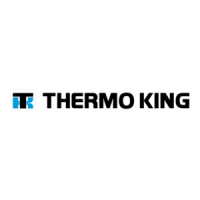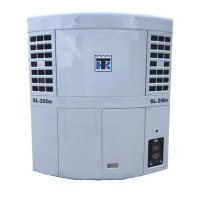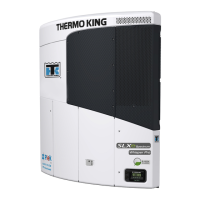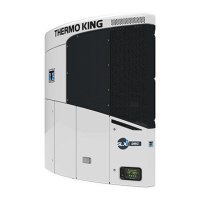Do you have a question about the Thermo King SL-200e and is the answer not in the manual?
Details the various microprocessor controllers used, including TG-VI, µP-IV, µP-V, µP-VI, SR-2, and SR-3.
Details continuous modes with and without modulation, and CYCLE-SENTRY modes for engine operation.
Explains the automatic start/stop system for fuel saving and temperature management.
Describes the HMI control panel, its display, and touch-sensitive keys for unit operation.
Provides step-by-step instructions for turning the unit on using the ON hard key.
Provides step-by-step instructions for turning the unit off using the OFF hard key.
Guides the selection of operating modes like CYCLE-SENTRY and Continuous Run for optimal product protection.
Provides steps for starting units in Continuous Run Diesel operation.
Details the procedure for starting Model 50 units on electric standby power.
Provides steps for starting units in CYCLE-SENTRY Diesel operation.
Outlines the procedure to identify a system with an excessive refrigerant charge.
Details the charging procedure for SLX, SLXe, SLXi SPECTRUM units, including calculations and steps.
Guides on using soap bubbles or a Halogen leak detector to test for refrigeration system leaks.
Provides detailed steps for evacuating the unit to achieve a deep vacuum.
Outlines the process for setting up, evacuating, and charging multi-temp refrigeration systems.
Emphasizes the importance of evacuation for system performance and recommends proper tools and procedures.
Provides essential safety guidelines for working with Thermo King units.
General safety precautions for unit operation and maintenance.
Explains the operation and safety precautions for CYCLE-SENTRY automatic start/stop systems.
Provides immediate medical assistance steps for electrical shock victims.
Details precautions for servicing microprocessor controllers to prevent electrostatic discharge damage.
Warns about the risks of electrical shock when working with temperature control units.
Provides detailed specifications for the TK 482, TK 486, and TK 486V engines, including oil and RPM.
Covers refrigerant types, charge amounts, compressor oil, and pressure settings for the refrigeration system.
Specifies controller types and setpoint ranges for various models like TG-VI, µP-IV, µP-V, µP-VI, SR-2, and SR-3.
Outlines inspection and service tasks for SLX, SLXe, and Spectrum host units based on service intervals.
Details inspection and service tasks for SLX, SLXe, and SPECTRUM remote evaporator units.
Outlines inspection and service tasks for SLXi host units and remote evaporators based on intervals.
Outlines inspection and service tasks for SLX, SLXe, and Spectrum host units.
Details inspection and service for SLXi host units and remote evaporators.
Explains how remote evaporator cycles between cool, null, and heat to maintain compartment temperature.
Explains engine operation modes like High Speed Cool, Low Speed Cool, and Defrost.
Describes the ETV, a variable position valve replacing modulation and compressor throttling valves.
Explains how defrost cycles are initiated automatically or manually and how they terminate.
Describes the automatic start/stop system for fuel saving and temperature management.
Explains how the TG-VI controller algorithm determines unit operating modes and features.
Details how µP-IV and µP-V software determine unit operating modes and features.
Explains operating characteristics of µP-VI, SR-2, and SR-3 software for various models.
Details operating characteristics of multi-temp systems for SL TCI and SPECTRUM units.
Explains the automatic start and CYCLE-SENTRY operation sequence in Diesel mode.
Explains the automatic start and CYCLE-SENTRY operation sequence in Electric Standby mode.
Lists protection devices for TG-VI, µP-IV, µP-V, µP-VI, SR-2/SR-3 control systems, and Spectrum Remote Evaporator.
Describes continuous run operation, including modulation cool and null modes.
Details the dedicated and soft keys on the SR-2/SR-3 control panel and their functions.
Provides step-by-step instructions for starting and operating units with SR-2/SR-3 controllers.
Details the essential pre-trip inspection steps to ensure proper unit operation before loading.
Provides step-by-step instructions for starting and operating units with SR-2/SR-3 controllers.
Lists protection devices such as fuses, low oil pressure switch, high pressure cutouts, and overload relays.
Details the essential pre-trip inspection steps to ensure proper unit operation before loading.
Explains how to perform pre-trip tests and unit self-checks for various controllers.
Details operations for entering setpoints, selecting modes, and initiating manual defrost for these controllers.
Details the TG-VI controller's functions, operation, and display screen elements.
Details the µP-VI controller's functions, operation, and display screen elements.
Describes the SR-2/SR-3 controller's functions, operation, and HMI control panel.
Explains operations for entering setpoints, selecting modes, and initiating manual defrost for the TG-VI controller.
Covers operations for entering setpoints, selecting modes, initiating defrost, and checking software versions.
Details HMI control panel operations, changing setpoints, selecting modes, and initiating defrost.
Provides steps to change the setpoint temperature for the µP-VI controller.
Provides steps to change the setpoint for the SR-2/SR-3 controller.
Describes the automatic functional check of unit operation, including results interpretation.
Lists and explains various alarm codes for different Thermo King controller models.
Details how to display, write down, and clear alarm codes.
Describes the automatic functional check of unit operation, including results interpretation.
Provides procedures for diagnosing charging system issues on alternators.
Covers engine oil change, oil filter change, and crankcase breather maintenance.
Details antifreeze maintenance, checking and changing antifreeze, and bleeding the cooling system.
Describes fuel system components, maintenance, bleeding the system, and water in fuel.
Details the procedure for changing engine oil, including draining and refilling.
Provides instructions for changing the spin-on oil filter.
Outlines regular inspection and replacement of antifreeze to maintain cooling system condition.
Covers injection pump installation and timing procedures for TK 482, TK 486, and TK 486V engines.
Emphasizes using only approved equipment dedicated to HFC refrigerant recovery.
Details procedures for checking and adjusting refrigerant charge in empty and loaded trailers.
Guides on using soap bubbles or a Halogen leak detector to test for refrigeration system leaks.
Outlines the process for setting up, evacuating, and charging multi-temp refrigeration systems.
Provides conditions and procedures for checking refrigerant charge with an empty trailer.
Outlines the procedure for charging the unit with refrigerant, including weighing and adding refrigerant.
Details procedures for checking refrigerant charge with a loaded trailer.
Provides procedures for correctly charging SLX, SLXe, SLXi SPECTRUM units.
Details the procedure for performing a low side pump down to equalize pressures and prepare for service.
Details compressor removal and installation steps, including clutch replacement and belt adjustments.
Details the removal and installation procedures for the Electronic Throttling Valve (ETV).
Provides diagnostic information for TK 482, TK 486, and TK 486V engines related to common conditions.
Troubleshoots issues where the unit is powered on but the engine does not crank.
Diagnoses conditions where the engine stops after starting, relating to fuel system and air intake.
Addresses causes and remedies for the engine overheating.
Diagnoses issues related to battery recharging or overcharging, checking electrical connections and alternator.
Diagnoses causes for the starter motor turning but the engine failing to start.
Addresses common issues when the engine cranks but fails to start.
Provides a diagnostic chart for common refrigeration system issues in most models.
Details the various microprocessor controllers used, including TG-VI, µP-IV, µP-V, µP-VI, SR-2, and SR-3.
Details continuous modes with and without modulation, and CYCLE-SENTRY modes for engine operation.
Explains the automatic start/stop system for fuel saving and temperature management.
Describes the HMI control panel, its display, and touch-sensitive keys for unit operation.
Provides step-by-step instructions for turning the unit on using the ON hard key.
Provides step-by-step instructions for turning the unit off using the OFF hard key.
Guides the selection of operating modes like CYCLE-SENTRY and Continuous Run for optimal product protection.
Provides steps for starting units in Continuous Run Diesel operation.
Details the procedure for starting Model 50 units on electric standby power.
Provides steps for starting units in CYCLE-SENTRY Diesel operation.
Outlines the procedure to identify a system with an excessive refrigerant charge.
Details the charging procedure for SLX, SLXe, SLXi SPECTRUM units, including calculations and steps.
Guides on using soap bubbles or a Halogen leak detector to test for refrigeration system leaks.
Provides detailed steps for evacuating the unit to achieve a deep vacuum.
Outlines the process for setting up, evacuating, and charging multi-temp refrigeration systems.
Emphasizes the importance of evacuation for system performance and recommends proper tools and procedures.
Provides essential safety guidelines for working with Thermo King units.
General safety precautions for unit operation and maintenance.
Explains the operation and safety precautions for CYCLE-SENTRY automatic start/stop systems.
Provides immediate medical assistance steps for electrical shock victims.
Details precautions for servicing microprocessor controllers to prevent electrostatic discharge damage.
Warns about the risks of electrical shock when working with temperature control units.
Provides detailed specifications for the TK 482, TK 486, and TK 486V engines, including oil and RPM.
Covers refrigerant types, charge amounts, compressor oil, and pressure settings for the refrigeration system.
Specifies controller types and setpoint ranges for various models like TG-VI, µP-IV, µP-V, µP-VI, SR-2, and SR-3.
Outlines inspection and service tasks for SLX, SLXe, and Spectrum host units based on service intervals.
Details inspection and service tasks for SLX, SLXe, and SPECTRUM remote evaporator units.
Outlines inspection and service tasks for SLXi host units and remote evaporators based on intervals.
Outlines inspection and service tasks for SLX, SLXe, and Spectrum host units.
Details inspection and service for SLXi host units and remote evaporators.
Explains how remote evaporator cycles between cool, null, and heat to maintain compartment temperature.
Explains engine operation modes like High Speed Cool, Low Speed Cool, and Defrost.
Describes the ETV, a variable position valve replacing modulation and compressor throttling valves.
Explains how defrost cycles are initiated automatically or manually and how they terminate.
Describes the automatic start/stop system for fuel saving and temperature management.
Explains how the TG-VI controller algorithm determines unit operating modes and features.
Details how µP-IV and µP-V software determine unit operating modes and features.
Explains operating characteristics of µP-VI, SR-2, and SR-3 software for various models.
Details operating characteristics of multi-temp systems for SL TCI and SPECTRUM units.
Explains the automatic start and CYCLE-SENTRY operation sequence in Diesel mode.
Explains the automatic start and CYCLE-SENTRY operation sequence in Electric Standby mode.
Lists protection devices for TG-VI, µP-IV, µP-V, µP-VI, SR-2/SR-3 control systems, and Spectrum Remote Evaporator.
Describes continuous run operation, including modulation cool and null modes.
Details the dedicated and soft keys on the SR-2/SR-3 control panel and their functions.
Provides step-by-step instructions for starting and operating units with SR-2/SR-3 controllers.
Details the essential pre-trip inspection steps to ensure proper unit operation before loading.
Provides step-by-step instructions for starting and operating units with SR-2/SR-3 controllers.
Lists protection devices such as fuses, low oil pressure switch, high pressure cutouts, and overload relays.
Details the essential pre-trip inspection steps to ensure proper unit operation before loading.
Explains how to perform pre-trip tests and unit self-checks for various controllers.
Details operations for entering setpoints, selecting modes, and initiating manual defrost for these controllers.
Details the TG-VI controller's functions, operation, and display screen elements.
Details the µP-VI controller's functions, operation, and display screen elements.
Describes the SR-2/SR-3 controller's functions, operation, and HMI control panel.
Explains operations for entering setpoints, selecting modes, and initiating manual defrost for the TG-VI controller.
Covers operations for entering setpoints, selecting modes, initiating defrost, and checking software versions.
Details HMI control panel operations, changing setpoints, selecting modes, and initiating defrost.
Provides steps to change the setpoint temperature for the µP-VI controller.
Provides steps to change the setpoint for the SR-2/SR-3 controller.
Describes the automatic functional check of unit operation, including results interpretation.
Lists and explains various alarm codes for different Thermo King controller models.
Details how to display, write down, and clear alarm codes.
Describes the automatic functional check of unit operation, including results interpretation.
Provides procedures for diagnosing charging system issues on alternators.
Covers engine oil change, oil filter change, and crankcase breather maintenance.
Details antifreeze maintenance, checking and changing antifreeze, and bleeding the cooling system.
Describes fuel system components, maintenance, bleeding the system, and water in fuel.
Details the procedure for changing engine oil, including draining and refilling.
Provides instructions for changing the spin-on oil filter.
Outlines regular inspection and replacement of antifreeze to maintain cooling system condition.
Covers injection pump installation and timing procedures for TK 482, TK 486, and TK 486V engines.
Emphasizes using only approved equipment dedicated to HFC refrigerant recovery.
Details procedures for checking and adjusting refrigerant charge in empty and loaded trailers.
Guides on using soap bubbles or a Halogen leak detector to test for refrigeration system leaks.
Outlines the process for setting up, evacuating, and charging multi-temp refrigeration systems.
Provides conditions and procedures for checking refrigerant charge with an empty trailer.
Outlines the procedure for charging the unit with refrigerant, including weighing and adding refrigerant.
Details procedures for checking refrigerant charge with a loaded trailer.
Provides procedures for correctly charging SLX, SLXe, SLXi SPECTRUM units.
Details the procedure for performing a low side pump down to equalize pressures and prepare for service.
Details compressor removal and installation steps, including clutch replacement and belt adjustments.
Details the removal and installation procedures for the Electronic Throttling Valve (ETV).
Provides diagnostic information for TK 482, TK 486, and TK 486V engines related to common conditions.
Troubleshoots issues where the unit is powered on but the engine does not crank.
Diagnoses conditions where the engine stops after starting, relating to fuel system and air intake.
Addresses causes and remedies for the engine overheating.
Diagnoses issues related to battery recharging or overcharging, checking electrical connections and alternator.
Diagnoses causes for the starter motor turning but the engine failing to start.
Addresses common issues when the engine cranks but fails to start.
Provides a diagnostic chart for common refrigeration system issues in most models.
| Brand | Thermo King |
|---|---|
| Model | SL-200e |
| Category | Refrigerator |
| Language | English |












